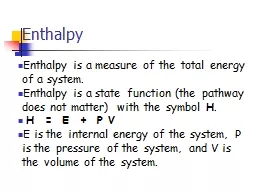

Enthalpy is a state function the pathway does not matter with the symbol H H E P V E is the internal energy of the system P is the pressure of the system and V is the volume of the system ID: 628418
Download Presentation The PPT/PDF document "Enthalpy Enthalpy is a measure of the to..." is the property of its rightful owner. Permission is granted to download and print the materials on this web site for personal, non-commercial use only, and to display it on your personal computer provided you do not modify the materials and that you retain all copyright notices contained in the materials. By downloading content from our website, you accept the terms of this agreement.
Slide1
Enthalpy
Enthalpy is a measure of the total energy of a system.
Enthalpy
is a state function
(the pathway does not matter) with
the symbol
H
.
H
= E +
P V
E
is the internal energy of the system, P is the pressure of the system, and V is the volume of the system.Slide2
Heat at Constant Pressure
The
change in enthalpy of a system has no easily interpreted meaning
except at constant pressure, where
D
H = heat
.
D
H
=
H
products
- H
reactants
.
At
constant
pressure
…
Exothermic
means
D
H is
negative.
Endothermic
means
D
H is positive.Slide3
Enthalpy
When 1 mole of methane is burned at constant pressure, 890 kJ of energy is released as heat. Calculate
D
H for a process in which a
5.8 g
sample of methane is burned at constant pressure.Slide4
Calorimetry
The device used experimentally to determine the heat associated with a chemical reaction is called a
calorimeter
.
Calorimetry
is the science of measuring
heat.
Heat
capacity
is the amount of heat required to raise an
object’s
temperature one degree.
* C =
heat absorbed
.
increase in temperatureSlide5
Heat Capacity
Specific
heat capacity
is the energy required to raise the temperature of one gram of a substance by one degree
Celsius.
units
are J/
o
C
.
g
or
J/
K
.
g
.
Molar
heat capacity
is the energy required to raise the temperature of one mole of a substance one degree
Celsius.
units
are J/
o
C
.
mol
or J/
K
.
mol
.Slide6
The equation
The symbol for heat energy is q (J)
Molar heat capacity is C (J/
mol
K)
Temperature is T, change in temperature is
T (K)
T is calculated by final temp-initial temp (
T
f
-T
i
)
The symbol for number of particles is n (
mol
)
q
= n C
T
q = n C
(
T
f
- T
i
)Slide7
------Or------
The symbol for heat energy is q (J)
specific heat capacity is c (J/ g K)
Temperature is T, change in temperature is
T (K)
T is calculated by final temp-initial temp (
T
f
-T
i
)
The symbol for mass m (g)
q
= m c
T
q = m c
(
T
f
- T
i
)Slide8
Heat Capacity
Some common values are found in Table 6.1, p 251.
* The higher the value, the longer it takes to heat an object and the longer it takes for that same object to cool.Slide9
If
the pressure remains constant, the process is called
constant-pressure
calorimetry
.
Calorimetry
experiments
can also be carried out under conditions of constant volume.
If
D
V = 0, P
D
V = 0, and
D
E = q
vSlide10
qlost =
q
gained
Sign convention
Losing energy means the value is negative.
Gaining energy means the value is positive.
The absolute value of the energy transferred will be the same
.
However,
losing
will be
negative
,
gaining
will be
positiveSlide11
Constant-Pressure
Calorimetry
I
When 1.00 L of 1.00 M Ba(NO
3
)
2
solution at
25.0
o
C
is mixed with 1.00 L of 1.00 M Na
2
SO
4
solution at
25
o
C
in a calorimeter, the white solid BaSO
4
forms and the temperature of the mixture increases to 28.1 C. Assuming that the calorimeter absorbs only a negligible quantity of heat, that the specific heat capacity of the solution is 4.18 J/
o
C
g, and that the density of the final solution is 1.0 g/mL, calculate the enthalpy change
per
mole of BaSO
4
formed.Slide12
Constant-Pressure
Calorimetry
II
One piece of copper jewelry
placed
at
100
o
C
has
exactly twice the mass of another piece, which is at
40
o
C
. They are placed inside a calorimeter whose heat capacity is negligible. What is the final temperature inside the calorimeter?
(c
of copper = 0.387 J/g K).Slide13
Constant-Pressure
Calorimetry
III
A .5269 g of octane is placed in a bomb calorimeter known to have a heat capacity of 11.3 kJ/C. The octane is ignited in the presence of gasoline. The temperature is increases by 2.25
o
C. What is the energy released per mole?Slide14
Enthalpy for phase changes
There are constant values for the enthalpy of a phase change.
The energy required to go from solid to liquid is called the heat of fusion (
H
fus
).
The energy required to go from liquid to gas is called heat of vaporization (
H
vap
).
q = H n
For heating a substance, q =
nC
T
or q
= mc T Slide15
Quantitative Aspects of Changes of State
The Heating-Cooling Curve.
Slide16
Problem
How much heat is required to heat 3.65
mol
of ice at –15
o
C to steam at 115
o
C?
H
fus
= 6010 J/
mol
H
vap
= 40,700 J/
mol
C
ice
= 38.09
C
water
=
75.3
C
steam
=
36.8
(
heat to melting-15 to 0) (heat to melt) (heat to boiling 0 to 100) (heat to boil off) (heat to 100 to 115)
q = 3.65 (
38.09)
15 + 3.65(6010) +3.65(75.3)100 + 3.65(40700) + 3.65(36.8)15
q =
202 kJ